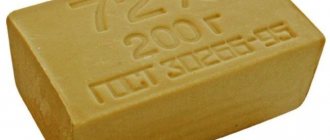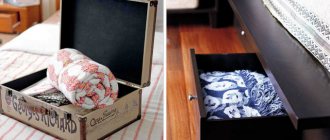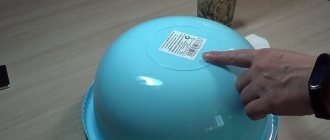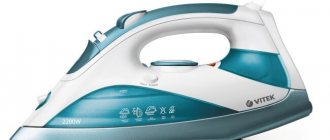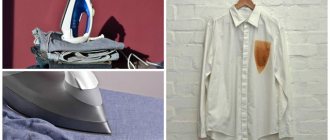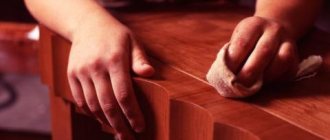Not all housewives manage to perfectly iron clothes with sleeves and small details. While you iron your sleeve, the front or back of your blouse may wrinkle. And sometimes it turns out even worse - in the most visible place of your favorite dress, the fabric suddenly shrinks or a hole with scorch marks appears. To prevent this from happening, it is necessary to perform this seemingly well-known action in a strictly defined sequence, observing a number of rules. We'll tell you how experienced housewives do it and their secrets of working with an iron.
Workplace organization
Before you get started, it's worth spending a little time on some preliminary preparation. This will save time and effort in the future.
- The surface of the ironing board should approximately be located at a height equal to the distance from the person’s elbow to the floor. Using smooth and multi-stage height adjustment, you can find a comfortable level for yourself. If you can adjust the position of the board, you can iron things not while standing, but while sitting on a sofa or chair.
- The soleplate of the iron and the steam chamber must be clean. The reservoir should be filled with filtered or boiled water.
- The work surface should be well lit. During the day, the board can be placed closer to the window.
- A stationary work place significantly saves time using folding and retractable boards, which do not need to be moved to the work area from the place of permanent storage each time.
- It is more convenient to use a large ironing board.
- The socket, if it is not built into the ironing board, should be conveniently located, and the cord should not interfere with operation.
- It is advisable to have a place where to put already ironed items and where to place a hot iron.
- The work surface must be safe and stable.
- The cover on the board should be soft, firmly and securely fastened, and not move when ironing along with the fabric. It's inconvenient, constantly distracting and slows down your work.
- Before starting work, clothes must be sorted into separate piles depending on the recommended ironing temperature. This way you won’t have to constantly change the temperature and switch the thermostat.
- It is advisable to prepare clothes hangers in advance.
- To prevent ironing from seeming so monotonous and tedious, you can do it while listening to music or in front of the TV.
If there is a lot of laundry, but, on the contrary, there is very little time, you can compromise and come to an agreement with yourself - first of all, iron the things that are needed. Everything else can be put aside for a while or you can skip this stage of caring for clothes altogether - carefully roll everything up after drying and put it in the closet.
Conclusion
Now I have finally found the answer to how to simplify ironing clothes - I solved this problem with the help of the DOMENA SP 2050 ironing press. Now I don’t pay much attention to the fact that I can accumulate a lot of it after several washes, knowing that I 1 hour will be enough to put it in order. It is especially necessary to emphasize that such ironing presses will be indispensable for mini hotels and small hotels.
In conclusion, I want to say that any problem can be solved sooner or later, the main thing is to set a goal and strive to achieve it. Of course, an ironing press is not such an important life attribute for which it was necessary to strive so hard.
There are more important goals in life, but if you make your life a little easier, you get the opportunity to use the free time for a more enjoyable pastime!
To stay up to date with new information, subscribe to the news
Dear readers! I would like to know your opinion, how you feel about ironing linen, especially bed linen, and how you cope with such work. If you use an ironing press for this purpose, please share your opinion in the comments.
How to choose the right temperature setting for your iron
The choice of temperature and ironing method is influenced by the composition of the fabric. A hint is provided by the care instructions on the labels attached by manufacturers to the side internal seams, to the back of the neck (jumper, T-shirt), and in the waistband area (skirts, trousers).
| Clothes can be ironed at any temperature without fear of ruining them. |
| Do not iron under any circumstances. Clothing may be deformed, the structure of the material may be damaged. |
| Items with this symbol can be ironed from the inside out, through the fabric, with a steam iron at temperatures up to 200 °C. Most often, the icon with three dots is found on items made of cotton and linen. |
| This icon allows you to iron things at moderate temperatures - up to 150 °C. The two-dot iron-on designation is commonly found on wool, viscose, and polyester blends. |
| You can iron things only at low temperatures - up to 110 °C without using steam, from the inside out or through the fabric. This mode is used for polyester, acrylic, synthetics, nylon. |
| Items with this icon cannot be steamed. There is a risk of leaving marks on them or ruining clothes. |
If the clothing does not have a label with recommendations, it is better to test the material before the first ironing: select the minimum temperature on the regulator, carefully iron the clothing in an inconspicuous place and see how the fabric reacts.
If the structure of the material begins to change and shrink, you cannot iron it. If nothing happens and the creases and folds do not disappear, you can slightly increase the temperature and iron the tested area again. Repeat these steps until the optimal temperature for the fabric is selected.
You can focus on the following indicators:
- linen fabrics can be ironed at temperatures from 190 to 230 °C;
- cotton products – from 165 to 190 °C;
- viscose – from 85 to 115 °C;
- silk – from 115 to 140 °C;
- wool clothes – from 140 to 165 °C.
If you have to iron a lot of clothes and linen from different fabrics, you need to start with those that require a minimum temperature, gradually increasing the parameters to maximum values.
Items with decorative details, embroidery, and sequins can only be ironed from the inside out.
Rule 4. The degree of drying of things
In order to iron your laundry efficiently and not spend too much time on it, you must initially dry the item correctly. To do this, consider the following recommendations:
- Linen and cotton items are easier to iron if they are slightly damp.
- Silk is straightened only when completely dry and from the inside out.
- Wool, flannel, tweed - dry, but for ironing use damp gauze, plus the last 2 work from the inside out.
- Colored knitwear - lightly moisten, but not just with water, but with a weak vinegar solution.
- Corduroy and velvet - iron only with steam after complete drying and, preferably, in a vertical position so as not to crush the pile.
- Any material with beads, rhinestones, or embroidery is smoothed only through a damp terry towel.
Secrets of successful ironing
- The fabric is carefully laid out on the board, avoiding the formation of folds and creases, which will be difficult to remove later.
- On items made of thin fabrics, you first need to press the seams to eliminate small gathers that form on them after washing and drying.
- In order not to spoil the clothes, you should iron them carefully, gently sliding over the surface of the material, without pressing the iron strongly and repeatedly to the same place, having previously set it to the desired temperature.
- It is better to iron clothes from the inside out.
- The iron must be pulled away from you, directed along the warp threads. This way the fabric stretches less. This rule also applies to models cut on the bias.
- To prevent seam allowances from being printed on the front side of the garment, you can place a sheet of paper under them. If prints do appear, you can iron the fabric again under the allowances on the wrong side. It is recommended to do the same when smoothing pockets.
- It is better to iron things in one layer to avoid creases and folds. To do this, you can use a special small board for smoothing sleeves, a small pillow, a thick roll of a folded towel, or the narrow part of the ironing board itself.
- The fabric should be slightly damp. Dry laundry is very difficult to iron. At the same time, if it is not completely dry and wet, yellow spots may form on it when ironing.
- Difficulties arise when smoothing out small folds and tucks. The latter are ironed from the inside out, running the iron along the seams, as if in the air, and holding the edge of the part on both sides. But here you can’t do without an assistant.
- To avoid distortions, duvet covers, sheets and other large items should be joined at the corners and ironed away from the face, neatly folded into four layers.
- If there is lint on the fabric, you need to iron it in its direction, and not against it.
- To prevent clothes from becoming deformed, it is recommended to iron them from top to bottom, starting with small parts: cuffs, darts, collars, pockets and waistbands. After that, move on to the sleeves, back, and shelves.
- When ironing knitted and knitted items, do not move the iron cloth over the surface. To prevent the material from stretching, the iron must be moved from one place to another.
- After ironing, it is not recommended to immediately put clothes away in the closet. You need to let it hang on a hanger for some time and cool. Ironed and immediately folded items may develop new wrinkles when stored in a closet.
Women's wardrobe
Women's clothing has its own characteristics of cutting and sewing, so girls need to learn how to properly iron their clothes.
- For skirts and dresses, the ironing process should begin at the top, gradually moving to the hem itself.
- Ironing things should be done crosswise, gradually moving to longitudinal ironing. The tip of the iron will help smooth out any wrinkles.
- Decorative elements (embroidery, lace) should be ironed only from the wrong side.
Before washing pleated skirts, it is better to baste the edges of the pleats with a bright, thin thread. Then it will be much easier to return the wrinkles during the smoothing process.
Why use gauze when ironing
Ironing some fabrics requires the use of additional materials: gauze or other material.
Gauze or cotton cloth soaked in water is used as a protective layer for very thin fabrics that cannot be ironed at high temperatures. For example, the permissible temperature for chiffon is 60 °C. Typically, the minimum setting on the iron regulator is 100 °C.
Iron very dry clothes through damp gauze if the iron does not have a steam function.
The fabric is used for ironing dark clothes so that shiny shiny stains from the iron do not remain on them. If streaks (shiny areas on clothing) do appear, they can be removed by wiping with a wet cloth.
It is convenient to iron thick areas of clothing through gauze and steam out folds. If you soak a fabric in a vinegar solution (1 tablespoon per liter of water), wring it out, lay it over the folds, you can iron creases on dress pants or hard folds that will retain their shape for a long time.
Rule 2. Proper ironing board
To quickly iron your clothes without getting tired, one good iron will not be enough.
Adjust the height of the board. The distance between the elbow and the surface of the board should be 27 cm. Be sure to take into account the position in which you are ironing - if sitting, then set the height of the board in this position, if standing, accordingly.
Important! If it is too high or low, your back will become stiff, pain will appear in your wrist and your arms will become overextended - you may even experience sore throat.
What to do if there is no iron or the product cannot be ironed
An iron is a device that is difficult to replace with anything in clothing care. But sometimes it also breaks down or is simply not available at the right time.
There are alternative methods for cases when there is no iron, or the clothes are very wrinkled and look unsightly, but the manufacturer has put a “do not iron” sign.
- You can smooth out wrinkles and folds with steam by hanging clothes over a bathtub or basin of hot water for half an hour. Then it needs to be dried flat.
- Lay the clothes on a damp terry towel, covering with another one on top.
- Use a steam generator or a special clothes humidifier.
- Moisten the clothes and put them in a bag for half an hour so that the moisture evenly saturates the fabric. Then smooth it out with your hands, especially on problem areas. And dry on a dryer or hanger.
Bring a leatherette bag back to life!
With these accessories, things are more complicated, because you won’t be able to iron the bag. But you don’t want to walk around with a wrinkled face? Then the following methods are for you.
- “Warm bath” is definitely a universal method. The only difference is that you should first fill the bag with newspaper or a towel.
- Water. You can moisten the bag with warm water, also fill it with newspaper and leave it to dry naturally (!).
- Hydration . Serious folds should be lubricated with glycerin or nourishing cream. For a light colored bag, you can use milk.
You should not use a hairdryer or heating devices for drying, because... In this case, the lining may shrink, and the bag will become covered with waves.
If your things are ironed and neat, then you will certainly inspire respect and trust from your interlocutor or partner. Be careful, because you can't make a first impression twice!
How to iron certain types of clothing
Blouses (shirts)
First, iron the cuffs, then the entire sleeve, back and yoke, shoulder seams and line of sleeves, collar - first from the inside, then from the face, moving the iron from the ends to the middle. Next, alternately - the right side of the fastener, then the left, if the product is fastened. If there is no fastener, first you need to iron the right side, then the left and the middle of the fabric last.
Skirt
Press the seams first from the inside, then from the face. Iron the bottom of the skirt without pressing the iron on the cut line. Iron the top of the product and iron the patches, folds and other details that are on the skirt.
Trousers
Iron seams, pockets, folds from the inside out. Turn it inside out and iron the waistband, the top of the trousers, the inside, then the outside.
Jeans
They are most often not ironed. But if necessary, do it from the inside out.
Kids' things
Always iron from the inside out at maximum temperature.
Rule 5. Direction of the iron and intensity of pressure
Nobody likes to iron clothes long and hard. Yes, this is not necessary at all. Are you sure you are using the iron correctly? Review the recommendations in the list below to see what you're doing wrong:
- Iron linen and knitwear with leisurely and smooth movements, direction - up or down. Do not move the iron hastily in circles over the material.
- Bedding sets, tablecloths and curtains - treat with light movements, from the front side, slightly moistening.
- The correct way to iron dresses is as follows: seams on the inside, darts, hem, then all other parts of the garment.
- Shirts: collar - from the corners to the middle, first the inside, then the front surface, sleeves - from the center to the edges, without forming an arrow.
Some tips for those who don't like ironing
When it comes to ironing, many housewives think about how to avoid this process. Often it is enough to wash a piece of clothing correctly so that after drying it looks perfect.
To avoid deep creases, choose a gentle wash cycle.
You can do without ironing if you follow the following rules:
- When washing in the washing machine, select the “No Crease” or “Easy Iron” cycles.
- Set the spin cycle to minimum speed, and after completing the cycle, shake the item thoroughly, then there will be fewer wrinkles on it.
- Buy clothes made from natural fabrics mixed with synthetic fibers - they are less prone to wrinkles.
- When washing by hand, do not twist the laundry with your hands, but let the water drain from it naturally.
- When packing for a trip, pack your things in your suitcase correctly. Even trousers and shirts that are susceptible to wrinkles for transportation should be rolled with a roller, as if rolling them into a roll.
This is what properly folded things look like
Ironing things without an iron at home is not so difficult if you are smart and keep at least a couple of the above methods in stock. All methods have been repeatedly tested in practice. Use our recommendations if it is not possible to use a classic ironing machine, and you need to make your clothes neat in the shortest possible time.



